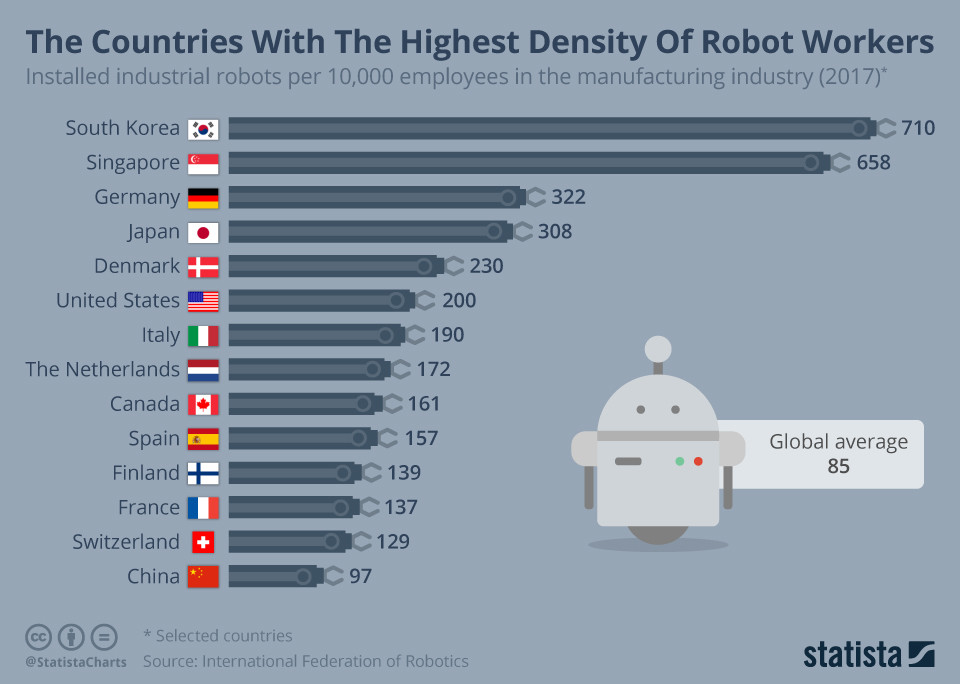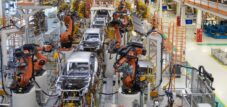Der Aufstieg der Maschinen hat bereits begonnen. Daten der International Federation of Robotics zeigen, dass sich das Tempo der industriellen Automatisierung in weiten Teilen der entwickelten Welt mit 74 installierten Industrierobotern pro 10.000 Mitarbeiter weltweit im Jahr 2016 beschleunigt. Ein Jahr später stieg dieser Wert im gesamten verarbeitenden Gewerbe auf 85. Europa hat eine Roboterdichte von 106 Einheiten pro 10.000 Arbeiter, und diese Zahl liegt in Amerika und Asien bei 91 bzw. 75. China ist eines der Länder mit den höchsten Wachstumsraten in der industriellen Automatisierung, aber nirgendwo gibt es eine Roboterdichte wie in Südkorea.
Im Jahr 2017 hatte Südkorea 710 Industrieroboter pro 10.000 Mitarbeiter installiert. Dies ist vor allem auf die anhaltende Installation von Großserienrobotern in der Elektronik- und Elektrobranche zurückzuführen. 90 Prozent der Industrieroboter in Singapur sind in der Elektronikindustrie installiert, und mit einer Dichte von 658 pro 10.000 Mitarbeiter liegt Singapur an zweiter Stelle. Deutschland und Japan sind bekannt für ihre Automobilindustrie und haben eine Dichte von gut 300 pro 10.000 Beschäftigten. Interessanterweise ist Japan mit einem Anteil von 56 Prozent am weltweiten Angebot einer der Hauptakteure in der Industrierobotik.
In den Vereinigten Staaten ist das Tempo der Automatisierung mit einer Dichte von 200 langsamer. China ist bestrebt, seinen Automatisierungsgrad in den kommenden Jahren auszubauen und strebt bis 2020 einen Platz in den Top-10-Ländern der Welt für die Roboterdichte an. Es hatte eine Dichte von 25 Einheiten im Jahr 2013 und wuchs bis 2017 auf 97. Im Jahr 2017 lieferte China bereits 36 Prozent der verkauften Roboter.
Im deutschen verarbeitenden Gewerbe kommen auf 10.000 Beschäftigte 322 Industrieroboter. Im Vergleich zu Südkorea hat die Automatisierung von Produktionsabläufen in anderen westlichen Industrienationen noch viel Luft nach oben, wie die Grafik zeigt. Auch in China, oft auch Werkbank der Welt genannt, ist der Kollege Roboter noch verhältnismäßig selten anzutreffen.
The rise of the machines has well and truly started. Data from the International Federation of Robotics reveals that the pace of industrial automation is accelerating across much of the developed world with 74 installed industrial robots per 10,000 employees globally in 2016. A year later, that increased to 85 across the manufacturing sector. Europe has a robot density of 106 units per 10,000 workers and that number is 91 and 75 in the Americas and Asia respectively. China is one of the countries recording the highest growth levels in industrial automation but nowhere has a robot density like South Korea.
In 2017, South Korea had 710 installed industrial robots per 10,000 employees. That is mainly due to the continued installation of high volume robots in the electronics and electric sectors. 90 percent of Singapore’s industrial robots are installed in its electronics industry and it comes second with a density of 658 per 10,000 employees. Germany and Japan are renowned for their automotive industries and they have density levels of just over 300 per 10,000 workers. Interestingly, Japan is one of the main players in industrial robotics, accounting for 56 percent of global supply.
In the United States, the pace of automation is slower with a density rate of 200. China is eager to expand its level of automation in the coming years, targeting a place in the world’s top-10 nations for robot density by 2020. It had a density rate of 25 units in 2013 and that grew to 97 by 2017. In 2017, China was already supplying 36 percent of the robots sold.
In the German manufacturing industry, there are 322 industrial robots per 10,000 employees. In comparison to South Korea, the automation of production processes in other western industrial nations still has a lot of room for improvement, as the chart shows. Even in China, often also called the world’s workbench, the robot colleague is still relatively rare.
You will find more infographics at Statista


